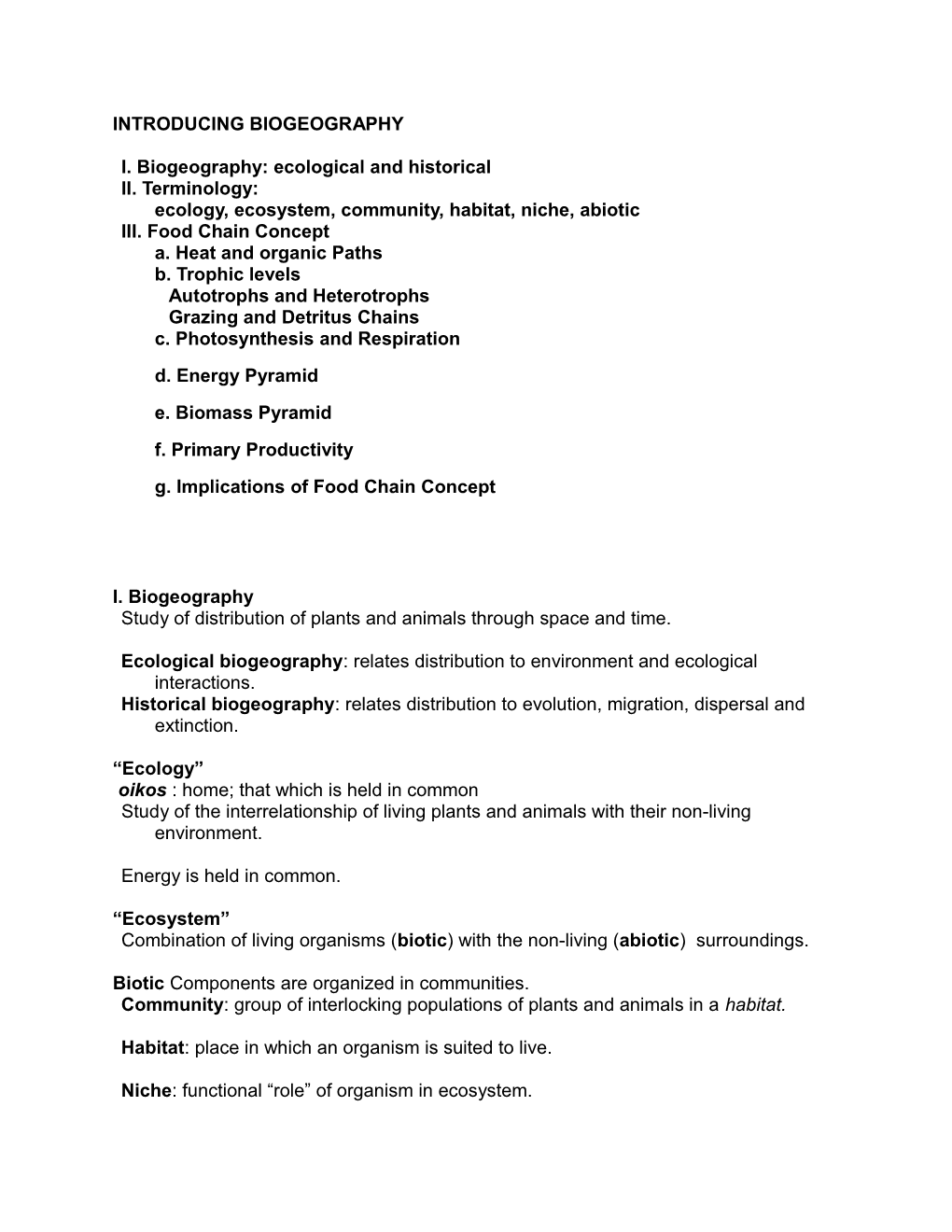INTRODUCING BIOGEOGRAPHY
I. Biogeography: ecological and historical
II. Terminology:
ecology, ecosystem, community, habitat, niche, abiotic
III. Food Chain Concept
a. Heat and organic Paths
b. Trophic levels
Autotrophs and Heterotrophs
Grazing and Detritus Chains
c. Photosynthesis and Respiration
d. Energy Pyramid
e.Biomass Pyramid
f. Primary Productivity
g. Implications of Food Chain Concept
I. Biogeography
Study of distribution of plants and animals through space and time.
Ecological biogeography: relates distribution to environment and ecological interactions.
Historical biogeography: relates distribution to evolution, migration, dispersal and extinction.
“Ecology”oikos: home; that which is held in common
Study of the interrelationship of living plants and animals with their non-living environment.
Energy is held in common.
“Ecosystem”
Combination of living organisms (biotic) with the non-living (abiotic) surroundings.
Biotic Components are organized in communities.
Community: group of interlocking populations of plants and animals in a habitat.
Habitat: place in which an organism is suited to live.
Niche: functional “role” of organism in ecosystem.
Example: Habitats of Canadian boreal forest
Community in upland habitat: red squirrels, pine and spruce trees, mushrooms, lichens, wolves, etc.
Niche of red squirrel:
Abiotic componentscycle through the earth-atmosphere
Nutrient cycles
Oxygen, nitrogen, carbon cycles, etc.
Water cycle
Energy : solar converted into other forms
III. Food Chain Concept:Recall solar radiation budget…69% insolation absorbed .
converted to other forms of energy
follows one of two pathways:
1.HEAT PATH (>99%)
2.ORGANIC PATH (< 1% )
a. Heat and organic paths
HEAT PATH
converted to heat by atmosphere, oceans, land surfaces.
hydrologic system, nutrient cycles, atmospheric circulation
ORGANIC PATH
converted to organic compounds in plants.
The energy that drives ALL LIFE ON EARTH!
b. Trophic levelsFOOD CHAIN: Sequence in which energy flows through trophic levels (successive consumer stages).
AUTOTROPHS :
manufacture living (organic) tissue from non-living (inorganic) chemicals and sunlight.
HETEROTROPHS :
rely on autotrophs.
c. Photosynthesis and respiration:Energy transfer
Green plants contain CHLOROPHYLL
reflects green; absorbs all other colors
absorption of light = absorption of energy
PHOTOSYNTHESIS:
CO2 + H2O + energy(sun) C6H12O6 (Glucose:carbohydrate)+ O2 Only autotrophs can do this!
RESPIRATION
How animals and plants derive energy for metabolism.
C6H12O6 +Oxygen CO2 + H2O + energy
Heterotrophsdo this.
Animals, roots, plants, microorganisms in soil
Grazing Chain (above ground)
Detritus Chain : the decomposers who consume dead organic matter (detritus)
Underground detritus food chain: On average, 10 times as much energy flows through the detritus chain as through the grazing chain.
d. ENERGY PYRAMID
Energy passed from one trophic level to the next. But, only 10% of energy
from each level gets passed along to the next level.
Where does the “wasted” energy go???
It is used in respiration for animal’s energy needs, some is not eaten, some is waste.
e. BIOMASS PYRAMID
Biomass: dry weight of organisms
1. terrestrial:
*largest bulk of mass is in plants
*2nd largest: decomposers
*next: successive trophic levels
2. marine:
upside down!
phytoplankton have less biomass than higher trophic levels.
f. Primary productivity
Gross primary productivity: rate at which energy is stored in organic chemicals by primary producers in photosynthesis.
In respiration, carbohydrates are broken down and energy is released; remaining carbohydrates can become plant tissue.
Net primary productivity: rate at which energy is stored in plant tissue.
Gross P.P. = Respiration + Net P.P.
g. Implications of Food Chain Concept
1. Biomass and Omnivorous Human Diet
2. Bioaccumulation:
substances stored in organic tissue become concentrated in successive trophic levels.
Example: Pesticide application
fat-soluble, stable chemicals(heavy metals, organic & synthetic chemicals, radioactive debris)
Become increasingly concentrated at successively higher trophic levels.
